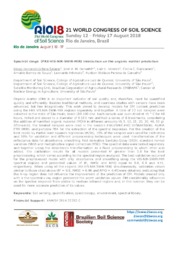Spectral range (FRX-VIS-NIR-SWIR-MIR) interaction on the organic matter prediction.
Spectral range (FRX-VIS-NIR-SWIR-MIR) interaction on the organic matter prediction.
Author(s): SALAZAR, D. U.; DEMATTÊ, J. A. M.; VICENTE, L. E.; GUIMARÃES, C. C.; SOUZA, A. B. de; INFORSATO, L.; CARVALHO, H. W. L. de
Summary: Organic matter (OM) is an important indicator of soil quality and, therefore, must be quantified quickly and efficiently. Besides traditional methods, and countless studies with sensors have been advanced, but few integratively. This work aimed to develop models for OM content prediction using the FRX-VIS-NIR-SWIR-MIR regions separately and together. A total of 22 soil samples were collected in the state of São Paulo, Brazil (80-100 cm). Each sample was oven dried at 45 ° C for 48 hours, milled and sieved to a diameter of 0.150 mm and had a series of 8 treatments, considering the addition of humified organic material (MOH) in different amounts (0, 5, 10, 15, 20, 30, 40, 50 g). Afterwards, the treated samples were read in the sensors FIELDSPEC-PRO (VISNIRSWIR), ALPHA FTIR (MIR), and portable FRX for the extraction of the spectral responses. For the creation of the best model by Partial least squares regression (PLSR), 70% of the samples were used for calibration and 30% for validation and different preprocessing techniques were used: transformation of the reflectance data for absorbance, smoothing, first derivative Savitzky-Golay (SGD), standard normal variation (SNV) and multiplicative signal correction (MSC). The spectral data were tested separately and together using the absorbance transformation as a fixed preprocessing to which other was added. The calibration results for all models presented R² greater than 0.8 for the best preprocessing, which varies according to the spectral region analyzed. The best validation occurred for the preprocessed model with only absorbance and smoothing using the VIS-NIR-SIWIR-MIR spectral regions and presented values of R², RMSE and RPIQ equal to 0.8, 6.8 and 4.55, respectively. When using all the regions (RX-VIS-NIR-SWIR-MIR) simultaneously, validation values similar to those cited above (R² = 0.8, RMSE = 6.96 and RPIQ = 4.45)were obtained, indicating that the X-ray region does not influence the improvement of the prediction of OM. Models created only with a the spectral x-ray region presented the worst validation values. OM considerably influences on the spectral response from visible to medium infrared regions and, in this manner, they can be used for more accurate prediction of its values.
Publication year: 2018
Types of publication: Abstract in annals or event proceedings
Unit: Embrapa Environment
Keywords: Environment, Organic matter, Soil sensing, Spectral library, Spectroscopy
Observation
Some of Embrapa's publications are published as ePub files. To read them, use or download one of the following free software options to your computer or mobile device. Android: Google Play Books; IOS: iBooks; Windows and Linux: Calibre.
Access other publications
Access the Agricultural Research Database (BDPA) to consult Embrapa's full library collection and records.
Visit Embrapa Bookstore to purchase books and other publications sold by Embrapa.

